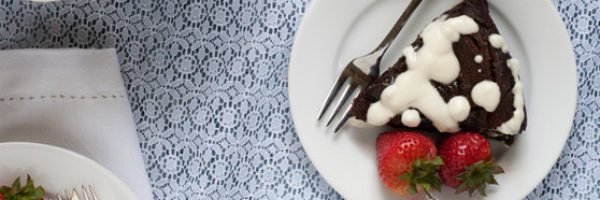
In the Kitchen: Psyllium for Gluten Free Baking
Q: I have a wheat sensitivity and eat gluten-free. I must also stay away from corn and tapioca starch. Almost every recipe for baked products calls for tapioca starch or cornstarch. What can I substitute so that I can bake gluten-free bread, cake, cookies and muffins?
A: Tapioca starch is generally considered a hypoallergenic ingredient but you are not alone in being sensitive to it. Fortunately, there are other items that can be used as one-for-one substitutions. Try arrowroot starch, potato starch (not flour) or sweet potato starch (or a combination) as a direct replacement for cornstarch in your recipes.
Q: I keep reading about psyllium in various blogs but I don’t know much about it. Can I use xanthan gum or flax meal instead in recipes that call for psyllium?
A: Psyllium is the newest darling of the gluten-free baking world. There’s a reason for this. Psyllium adds beneficial texture to gluten-free baked foods, making them more moist and tender. It even allows you to knead gluten-free bread dough—a treat for those of us who miss this aspect of bread making.
Psyllium is an all-natural fiber that comes from the plantago (or psyllium) plant. When combined with liquid, psyllium becomes gelatinous and gluey. It is used primarily as a colon cleanser—but don’t let that be a turn off! Psyllium happens to be terrific in gluten-free baking. And you don’t use all that much. Depending on the recipe, 2 to 4 tablespoons is all you need.
Psyllium is available in whole husk and powdered forms. You can purchase both types in natural food stores. Because of the difference in density, the two forms are not 100 percent interchangeable in recipes. You’ll need to experiment if replacing whole husk for powder.
If you don’t want to use psyllium or can’t find it, you can replace it with xanthan gum but this is definitely not a one-for-one substitution. It’s more like 1 teaspoon of xanthan gum for 2 to 3 tablespoons of psyllium. You might need to add a bit more of one of the flours in your recipe to balance the ratio of wet to dry. You can use flax meal as a one-for-one replacement but add a pinch or two of extra xanthan gum to your recipe to keep your baked goods from getting crumbly. It may take a bit of trial and error in each recipe until you achieve the results you like.
I have a great recipe for gluten-free pizza crust but I’d like to increase the chewiness. Can I add something to my flour blend (it’s white rice flour, millet flour, tapioca starch, potato starch) to make the crust more chewy?
I always add millet flour to create more chewiness—but it’s already in your blend. So here are a few other ideas. First, check the amount of xanthan gum in your recipe—1½ teaspoons of xanthan gum per cup of gluten-free flour blend is recommended for pizza crust. If you’re already using that amount, try adding 1 tablespoon of potato flour (not potato starch) to the dry ingredients. Potato flour adds a chewy mouth-feel to baked goods. Finally, place the pizza on the lowest rack of your oven and bake it at a high temperature. (Generally, 425°F is best.)
Q: When I melt chocolate, it turns hard and grainy. My instinct tells me to heat it again but that just makes it worse. Can you help?
A: Your chocolate has “seized,” as they say in the world of bakers. Seizing is triggered when tiny particles of moisture, like a whiff of steam, combine with hot cocoa butter. It can also occur if chocolate is overheated. The result is a solid, dull mass—just the opposite of what you want.
A few tips can help prevent chocolate from seizing: Make sure the chocolate pieces are uniform in size so they melt evenly. To avoid any chance encounter with water or steam, be certain all bowls and utensils are completely dry. Heat the chocolate gently over low or low-medium heat, as overheating can also cause the chocolate to solidify. The best way to melt chocolate is to place it in a microwavable bowl that does not hold the heat. (A Pyrex bowl is perfect.) Heat the chocolate in the microwave over medium heat at 30-second intervals, stirring and repeating until the chocolate is melted. Some recipes call for melting chocolate with cream. This method is nearly foolproof, as the cream helps the chocolate melt evenly without scorching.
There is a way to revive seized chocolate. Add warm water, a few drops at a time, and stir vigorously after each addition to smooth the chocolate back to its former satiny texture. To restore the sheen, add several drops of vegetable oil. You won’t want to use restored chocolate for dipping or eating straight from the bowl but it’s fine for folding into frosting or batter.
Written by Beth Hillson, originally published in Gluten Free & More.




I’m experimenting with gf baking, but don’t like flaxseed. Do I HAVE to use flaxseed? It seems that all the recipes ask for flaxseed. Can you help me?
Hi Grace,
Flaxseed replacements depend on the recipe. Sometimes flaxseed is ground up and mixed with water to create an egg replacer, in which case you can usually just use an egg, but again it depends on the recipe and the purpose for the flaxseed in the recipe.
hello! I was wondering can you use psyllium husk in all dessert making recipes as a substitute or only substitute them for certain ingredients?
Hi Veronica,
You can use psyllium as a replacement for xanthan gum or flax seed meal. This post explains the ratios are not 1-to-1 for xanthan gum but are 1-to-1 for flax seed meal.
Hope this helps!